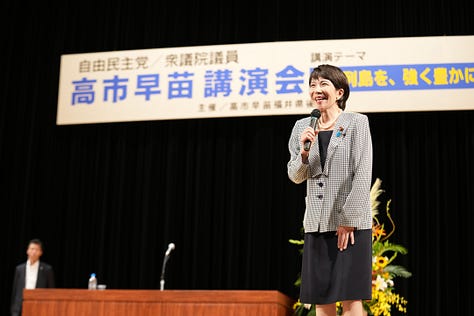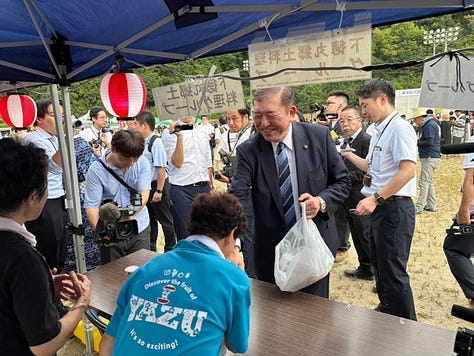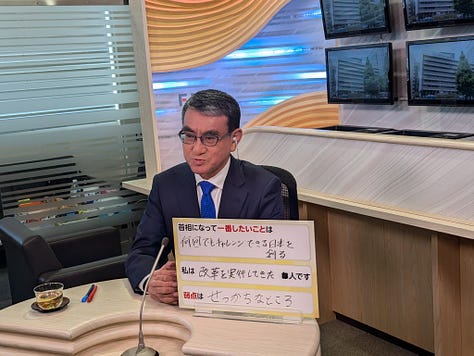Up for grabs
Koizumi and Ishiba battle for grassroots supporters, while Takaichi looms
Thank you for reading Observing Japan. This post is available to all readers.
If you are looking for timely, forward-looking analysis of the stories in Japans’s politics and policymaking that move markets, I have launched a new service through my business, Japan Foresight LLC. For more information about Japan Foresight’s services or for information on how to sign up for a trial or schedule a briefing, please visit our website or reach out to me.



A series of polls over the weekend provide new data regarding the shape of the Liberal Democratic Party (LDP) leadership race and how the public views the contest. Across the board, these polls find that Koizumi Shinjirō and Ishiba Shigeru are battling for the lead among party supporters, with Takaichi Sanae firmly in third place, Kobayashi Takayuki, Kamikawa Yōko, and Kōno Tarō clustered around 5% to 7% support, and the remaining five or six polling between 0% and 2%. As the field takes shape, there is still no clear frontrunner.
For the most part, none of the polls show Koizumi with as sizeable a lead as last week’s Nikkei Shimbun poll found (discussed here). In the new Asahi Shimbun poll, Koizumi leads Ishiba among LDP supporters 28% to 23%, with Takaichi at 12% Kōno at 8%, Kamikawa at 7%, and Kobayashi at 5%. In the Yomiuri Shimbun poll, Koizumi leads Ishiba among LDP supporters by a 22% to 20% margin, followed by Takaichi at 14%, Kōno at 9%, Kamikawa at 6%, and Kobayashi at 6%. The new Mainichi Shimbun poll is most favorable for Ishiba – he has a sizable 29% to 16% edge over Koizumi with the public at large and a 25% to 24% lead with LDP supporters – but it also suggests the possibility of a three-way race, with Takaichi close behind the leaders with 19% support among LDP supporters. Kobayashi ranks fourth with 9%, followed by Kamikawa with 6% and Kōno with 5%. The most favorable poll for Koizumi, meanwhile, was the Sankei-Fuji News poll, in which he enjoys a 29.4%-23% lead over Ishiba among LDP supporters, followed by Takaichi at 15.3%.
Other questions in these polls reveal how the public is thinking about the LDP race and how the next prime minister should govern. While the public wants the next LDP leader to press on with campaign finance reforms – 69% of the public as a whole, as well as 63% of LDP supporters indicated in the Asahi poll that reform should continue – but “politics and money” does not rank as a top issue for voters in any poll. In the Asahi poll, it was a distant (19%) third, behind the economy (32%) and social security (27%). The economy and social security were likewise the most popular choices in the Yomiuri poll, favored by 29% and 23% of respondents respectively. In the Sankei-FNN poll, in which respondents could select two issues, campaign finance ranked fourth, behind inflation, wages, and economic policy (59.7%), pensions and healthcare (35.9%), and family support (29.3%). In Mainichi, it was third (15%) behind inflation (21%) and economic policy (18%). It is not altogether surprising that economic policy is top of mind for voters – as is virtually always the case – but despite these preferences, each candidate’s stance towards political reform will likely receive outsized attention during the campaign, perhaps because there may be more differences between the candidates on political reform than on economic policy.1
Meanwhile, these polls suggest that voters may be looking for a more energetic executive. In the Asahi Shimbun poll, in which respondents could choose one quality they are seeking in the next LDP leader, the most popular choice was “the ability to get things done” with 49%. Yomiuri’s poll, in which respondents could select any number of qualities, 82% said they wanted a trustworthy leader, 79% a reform-minded leader, 68% a good communicator, and 63% said they wanted a leader whose policies they support.
The upshot is that opinion polls suggest that LDP voters – whose votes will carry significant weight in deciding who makes the runoff with a large, divided field – have not necessarily coalesced around a single favorite. Koizumi enters the race with a strong following and still may have the advantage in that he could also bring along a significant number of lawmakers, but Ishiba’s support is robust, particularly among older voters. And Takaichi, despite questions about the extent of her support among lawmakers, could nevertheless get a sizable boost from LDP supporters, which could give her a chance of advancing to the runoff. Meanwhile, Kōno, whose support fell to as low as sixth place in the Mainichi poll, faces an uphill battle to advance, let alone win outright. The race, however, is still fluid, and as others declare their candidacies, party voters could still reconsider who they prefer in the contest.
With the exception of right-wing candidates like Takaichi and Kobayashi, who are both opposed to fiscal consolidation and monetary policy normalization.





